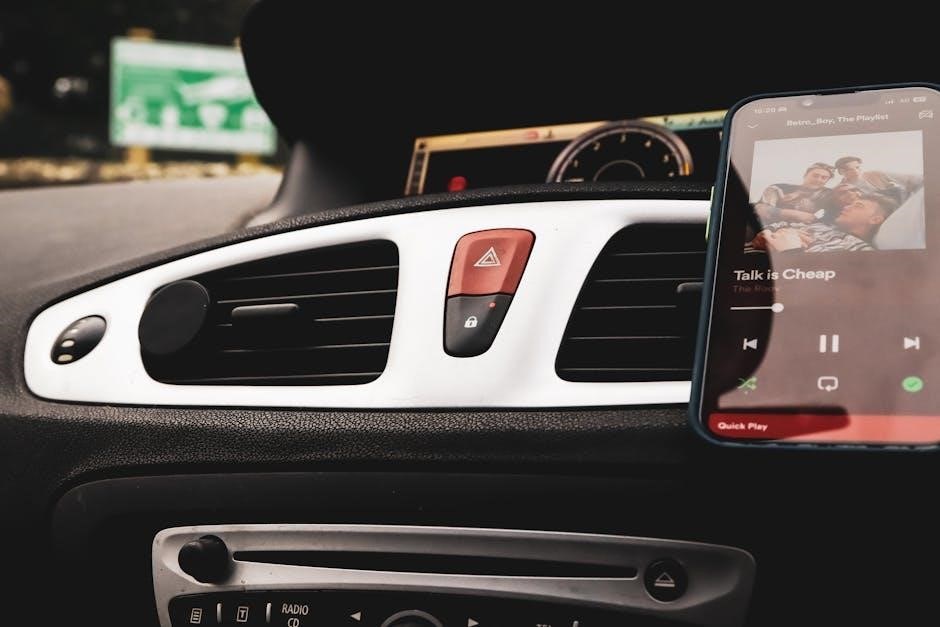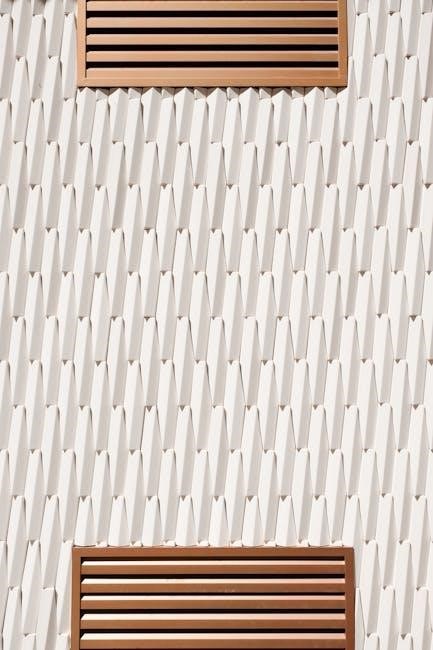The Vent-Axia Sentinel Kinetic is a high-efficiency Mechanical Ventilation with Heat Recovery (MVHR) unit designed for energy-efficient ventilation in homes, ensuring optimal indoor air quality and compliance with building regulations.
1.1 Overview of the Vent-Axia Sentinel Kinetic Series

The Vent-Axia Sentinel Kinetic series offers a range of advanced Mechanical Ventilation with Heat Recovery (MVHR) units designed for energy-efficient ventilation in residential properties. These units are engineered to maintain superior indoor air quality while minimizing energy consumption. The series includes models like Sentinel Kinetic B, F, and High Flow, catering to various dwelling sizes and ventilation needs. Each model features intelligent controls, heat recovery, and humidity tracking, ensuring compliance with building regulations and optimal performance. The series is known for its flexibility, with options for vertical or horizontal installation, making it suitable for diverse applications.
1.2 Key Features and Benefits
The Vent-Axia Sentinel Kinetic series boasts high-efficiency performance, reducing energy consumption while maintaining excellent indoor air quality. Its advanced heat recovery system recirculates warmth, lowering heating costs. The intelligent humidity tracking feature prevents moisture buildup, ensuring a healthier environment. The units are designed with backward-curved impellers for quiet operation and high airflow. Compact and versatile, they offer flexible installation options, including vertical or horizontal mounting. Compliance with building regulations and whisper-quiet performance make them ideal for residential use, enhancing comfort and energy efficiency.

Installation and Commissioning
The Sentinel Kinetic can be installed vertically in a roof space or horizontally in a cupboard, ensuring flexibility. Proper insulation and ducting are essential for optimal performance.
2.1 Pre-Installation Checklist
Before installing the Vent-Axia Sentinel Kinetic, ensure the site is prepared, including proper structural support and access. Verify all components are included and undamaged. Check compliance with Building Regulations and Domestic Ventilation Compliance Guide. Ensure electrical connections meet requirements and ducting is appropriately sized. Insulate ducts in unheated areas as specified. Review the installation manual for specific instructions. Ensure safety precautions, such as disconnecting power supplies, are taken. Confirm the system’s orientation aligns with space constraints and ventilation needs.
2.2 Step-by-Step Installation Guide
Mount the Vent-Axia Sentinel Kinetic unit vertically in a roof space or suitable cupboard. Connect the ducting system, ensuring proper seals to prevent air leakage. Install the heat exchanger and connect it to the unit. Follow the wiring diagram to connect electrical components, ensuring all connections are secure. If installed in an unheated area, insulate the ducting as per the Domestic Ventilation Compliance Guide. Align the unit’s spigots correctly with the ducting system. Double-check all connections and ensure the system is level. Refer to the installation manual for detailed diagrams and specific instructions.

2.3 Commissioning the Unit
Commissioning ensures the Vent-Axia Sentinel Kinetic operates efficiently. Power up the unit and check for any unusual noises or vibrations. Verify that all ducting connections are secure and properly sealed. Set the system to its default mode and monitor airflow rates to ensure they meet specifications. Use the control panel to test humidity tracking and heat recovery functions. Check for any alarms or fault codes and address them according to the user guide. Finally, record the commissioning details for future reference and maintenance scheduling.

Operation and Monitoring
The Sentinel Kinetic operates efficiently, with real-time monitoring of airflow, humidity, and system performance. Adjust settings via the control panel to optimize energy use and indoor air quality.
3.1 Understanding the Control Panel
The Vent-Axia Sentinel Kinetic control panel is an intuitive interface designed for easy operation and monitoring. It features a touchscreen display with clear menus, allowing users to adjust settings, monitor system performance, and access advanced features like humidity tracking and energy-efficient modes. The panel provides real-time data on airflow rates, humidity levels, and system status, ensuring optimal control over indoor air quality. Its user-friendly design makes it simple to navigate and customize settings to meet specific ventilation needs, while also offering advanced diagnostics for troubleshooting. Regular updates ensure enhanced functionality and performance.
3.2 Basic Operation Modes
The Vent-Axia Sentinel Kinetic operates in several basic modes to ensure efficient ventilation. The Energy Saving Mode optimizes airflow while reducing energy consumption. The Boost Mode increases ventilation rates for rapid air exchange, ideal for high-pollution events or after cooking. The Humidity Boost Mode automatically adjusts airflow based on moisture levels, preventing condensation. These modes can be manually selected via the control panel or set to run automatically, ensuring seamless adaptation to changing indoor conditions. This flexibility allows users to balance energy efficiency with air quality, tailoring the system to their specific needs.
3.3 Monitoring System Performance
The Vent-Axia Sentinel Kinetic features a user-friendly control panel that allows real-time monitoring of system performance. Key metrics such as airflow rates, humidity levels, and temperature are displayed, enabling precise adjustments. Fault codes provide immediate alerts for any issues, guiding troubleshooting. Regular maintenance alerts ensure filters and ductwork are inspected, optimizing efficiency. This comprehensive monitoring ensures the system operates effectively, maintaining indoor air quality and prolonging its lifespan.

Maintenance and Servicing
Regular maintenance ensures optimal performance of the Vent-Axia Sentinel Kinetic. This includes filter cleaning, ductwork inspection, and checking for blockages. The control panel provides maintenance alerts.
4.1 Routine Maintenance Tasks
Regular maintenance is essential to ensure the Vent-Axia Sentinel Kinetic operates efficiently. Routine tasks include cleaning or replacing filters every 1-3 months, inspecting ductwork for blockages, and checking for dust buildup. The control panel alerts users when maintenance is required. Additionally, ensure all vents and grilles are clear of obstructions. For optimal performance, clean the heat exchanger annually and inspect the impeller for dust. Always use genuine Vent-Axia replacement filters to maintain efficiency. Refer to the user manual for detailed instructions and recommended schedules.
4.2 Filter Cleaning and Replacement
Regular filter maintenance is crucial for the Vent-Axia Sentinel Kinetic’s efficiency. The G4 pre-filter should be cleaned every 1-3 months using a vacuum cleaner or soft brush and replaced annually. The F7 pollen filter, if fitted, should also be cleaned monthly and replaced every 12 months; Both filters are accessed via the unit’s hinged door. Always use genuine Vent-Axia replacement filters to ensure optimal performance. Refer to the user manual for detailed instructions and diagrams. Clean filters ensure improved airflow and energy efficiency, preventing system strain and maintaining indoor air quality.
4.3 Ductwork Inspection and Cleaning
Regular inspection of the ductwork is essential to ensure optimal performance of the Vent-Axia Sentinel Kinetic. Inspect ducts every 6-12 months for dust buildup, blockages, or damage. Clean ducts using a vacuum cleaner or soft brush to remove debris. Ensure all bends, joints, and grilles are clear. Damaged or leaking ducts should be repaired or replaced promptly. Cleaning prevents reduced airflow, increased energy consumption, and potential system inefficiency. Always switch off the unit before cleaning and refer to the user manual for detailed guidance on maintaining ductwork integrity and performance.

Troubleshooting
This section provides guidance on diagnosing and resolving common issues with the Vent-Axia Sentinel Kinetic. Refer to the manual for detailed fault codes and solutions to ensure optimal performance.
5.1 Common Issues and Solutions
Common issues with the Vent-Axia Sentinel Kinetic include faulty sensors, blocked filters, or the system not turning off. Solutions involve checking sensor connections, cleaning or replacing filters, and resetting the unit. Ensure ductwork is clear and insulated. If the unit is noisy, inspect for loose components or debris. For error codes, consult the manual or contact support. Regular maintenance, like cleaning filters, prevents many issues. Addressing problems promptly ensures efficient operation and maintains indoor air quality. Always follow the manufacturer’s guidelines for troubleshooting and repairs.
5.2 Understanding Fault Codes
The Vent-Axia Sentinel Kinetic displays fault codes to indicate specific issues, such as sensor malfunctions or system errors. These codes, found in the user manual, help diagnose problems quickly. For example, fault codes may signal humidity sensor issues or communication errors between components. Referencing the manual ensures accurate troubleshooting and maintenance, allowing users to resolve issues efficiently and maintain optimal performance. Understanding these codes is crucial for proactive system care and preventing operational disruptions.
5.3 Resetting the System
To reset the Vent-Axia Sentinel Kinetic system, navigate to the control panel and locate the reset option. Follow the on-screen instructions to restore default settings. Ensure power is cycled if prompted. Resetting can resolve minor glitches without affecting custom configurations. Always consult the user manual before performing a reset to avoid unintended changes. This step ensures the system operates efficiently and maintains optimal performance. Resetting is a straightforward process that helps troubleshoot common issues effectively.

Advanced Features
The Vent-Axia Sentinel Kinetic features intelligent humidity tracking, heat recovery management, and a high-efficiency impeller design. These advanced technologies ensure optimal energy efficiency and indoor air quality.
6.1 Intelligent Humidity Tracking
The Vent-Axia Sentinel Kinetic features intelligent humidity tracking, which monitors moisture levels in real-time to ensure optimal indoor air quality. This advanced system automatically adjusts ventilation rates to prevent excessive humidity, reducing the risk of condensation and mold growth. By maintaining a balanced humidity level, it enhances comfort while preserving the structure of the building. The system integrates seamlessly with other sensors and controls, ensuring efficient operation and energy savings. This feature is particularly beneficial in high-moisture areas, such as kitchens and bathrooms, making it a key component for maintaining a healthy and energy-efficient home environment. Its user-friendly design ensures ease of operation and customization.
6.2 Heat Recovery Management
The Vent-Axia Sentinel Kinetic incorporates advanced heat recovery management, capturing energy from extracted air and transferring it to fresh incoming air. This process minimizes heat loss, reducing energy consumption and lowering utility bills. The system ensures that up to 90% of heat is recovered, maintaining a comfortable indoor environment while promoting sustainability. By integrating intelligent sensors and controls, the unit optimizes heat recovery efficiency, adapting to changing conditions such as temperature and humidity levels. This feature is essential for achieving energy efficiency and compliance with modern building standards, making it a cornerstone of the Sentinel Kinetic’s performance. Its design ensures minimal energy waste, providing long-term environmental and economic benefits.
6.4 High Efficiency Impeller Design
The Vent-Axia Sentinel Kinetic features a high-efficiency impeller design with backward-curved blades, optimizing airflow while minimizing energy consumption. This advanced design ensures silent operation and exceptional performance across a wide range of applications, from small apartments to large homes. The impeller’s aerodynamic profile reduces turbulence, enhancing efficiency and reliability. Its robust construction ensures durability, maintaining peak performance over time. This design contributes significantly to the system’s energy-saving capabilities, making it a key feature in achieving high efficiency and meeting modern environmental standards for ventilation systems.

Upgrading or Replacing the System
Upgrade or replace your Vent-Axia Sentinel Kinetic to enhance performance or integrate new features. The process ensures minimal disruption, maintaining optimal indoor air quality and energy efficiency.
7;1 When to Upgrade
Consider upgrading your Vent-Axia Sentinel Kinetic when seeking improved performance, additional features, or enhanced energy efficiency. Upgrade if your current system no longer meets airflow requirements, is outdated, or requires frequent repairs. Newer models, like the Sentinel Kinetic High Flow, offer advanced capabilities such as higher efficiency and smarter humidity tracking. Upgrading ensures compliance with updated building regulations and optimizes indoor air quality. Consult a professional to determine the best upgrade path for your specific needs and ensure compatibility with your existing ductwork and ventilation setup.
7.2 Upgrade Options
The Vent-Axia Sentinel Kinetic series offers several upgrade options to enhance performance. Users can upgrade to the Sentinel Kinetic High Flow for increased airflow and efficiency. Another option is the Sentinel Kinetic Plus, which includes advanced features like superior heat recovery and quieter operation. Additionally, upgrading to the Sentinel Kinetic BH or FH models provides improved humidity tracking and energy-saving capabilities. These upgrades ensure compatibility with existing ductwork and ventilation systems, making the transition seamless while improving overall system performance and energy efficiency.
7.3 Replacement Process
Replacing a Vent-Axia Sentinel Kinetic unit involves several steps to ensure a smooth transition. First, switch off the power supply and disconnect the unit from electrical and ductwork connections. Carefully remove the old unit, taking note of its position and mounting points. Install the new unit following the manufacturer’s guidelines, ensuring proper alignment and secure connections. Reconnect the ductwork and electrical systems, then test the unit to confirm proper operation. Always refer to the user manual or installation guide for specific instructions. Professional assistance is recommended for complex setups.
The Vent-Axia Sentinel Kinetic offers efficient ventilation and heat recovery, ensuring compliance with building standards. Its advanced features and proper usage guidance enhance indoor air quality and energy savings.
8.1 Summary of Key Points
The Vent-Axia Sentinel Kinetic series offers advanced MVHR solutions, combining energy efficiency with exceptional indoor air quality. Designed for compliance with building regulations, these units feature intelligent humidity tracking, heat recovery management, and high-efficiency impeller designs. Suitable for various dwelling types, they ensure optimal performance in apartments and houses. Proper installation, maintenance, and operation are crucial for maximizing energy savings and system longevity. Regular tasks like filter cleaning and ductwork inspection are essential for sustained efficiency. By following the user guide, users can unlock the full potential of their Sentinel Kinetic system.
8.2 Final Tips for Optimal Performance
For optimal performance, ensure regular maintenance tasks such as filter cleaning and ductwork inspections are carried out. Always follow the manufacturer’s guidelines for installation and servicing. Use the control panel to monitor and adjust settings efficiently. Maintain proper insulation in unheated areas where the unit is installed. Regularly check for software updates to enhance functionality. Refer to the user manual for troubleshooting common issues promptly. Proper configuration of the system according to your home’s size and layout is essential for energy efficiency and air quality. Monitor performance metrics to identify and address potential issues early.

Further Resources
For additional support, visit the official Vent-Axia website for user manuals, FAQs, and contact information. Access resources at Vent-Axia.com.
9.1 Official Vent-Axia Documentation
The official Vent-Axia website provides comprehensive documentation for the Sentinel Kinetic series, including installation, commissioning, and user manuals. These resources are available for free online viewing or downloading in PDF format. Manuals cover various models, such as the Sentinel Kinetic B, Sentinel Kinetic Plus, and Sentinel Kinetic High Flow. Visit Vent-Axia.com to access these guides, ensuring you have the most up-to-date information for proper installation, operation, and maintenance of your unit.
9.2 Online Support and FAQs
Vent-Axia offers extensive online support and FAQs to assist users with their Sentinel Kinetic systems. Their website features dedicated sections for troubleshooting, installation tips, and operational guidance. Users can access FAQs, user guides, and technical specifications to resolve common issues. Additionally, Vent-Axia provides customer support via phone, email, and live chat for more complex queries. These resources ensure seamless operation and maintenance of your Sentinel Kinetic MVHR system, addressing all potential concerns effectively.
9.3 Contact Information for Assistance
For further assistance, Vent-Axia provides dedicated customer support. Visit their official website at https://www.vent-axia.com for contact details. You can reach their team via phone at +44 (0)344 856 0590 or email at technical@vent-axia.com. Additionally, their website offers a “Contact Us” section with a form for inquiries. For specific support, refer to the “Residential Systems Manuals” section, accessible via QR codes on product packaging or directly on their site.